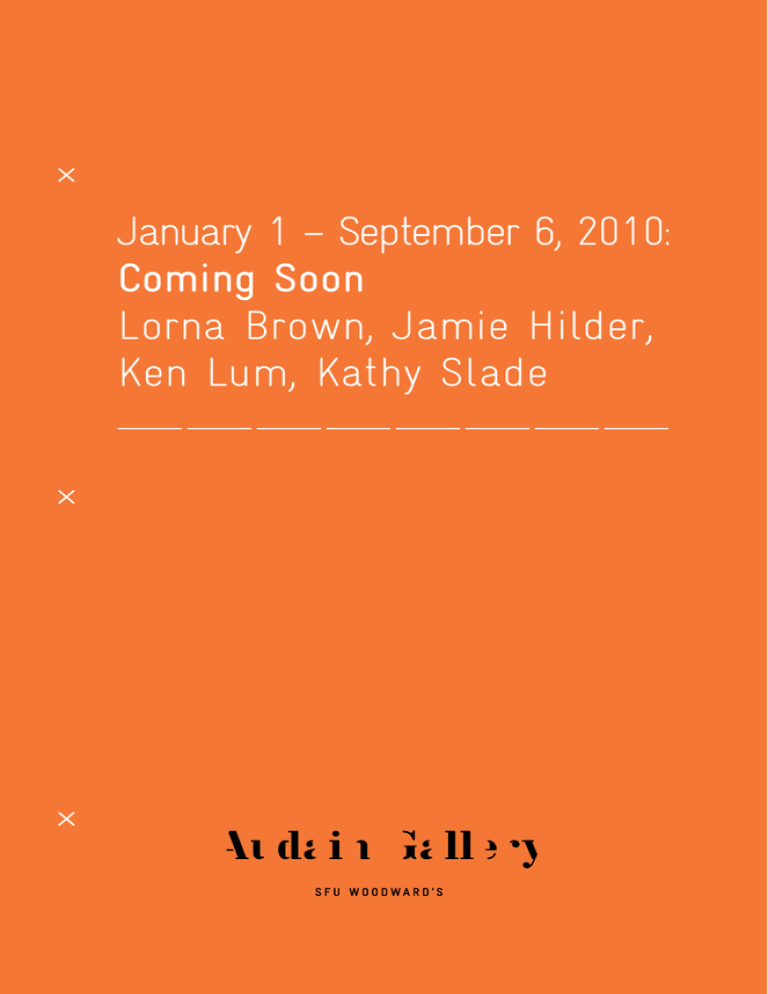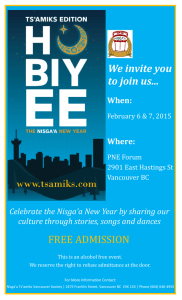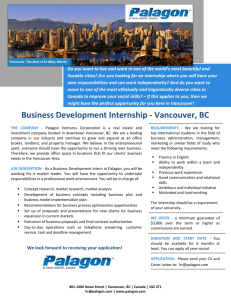January 1 – September 6, 2010: Coming Soon Lorna Brown, Jamie Hilder,
advertisement

January 1 – September 6, 2010: Coming Soon Lorna Brown, Jamie Hilder, Ken Lum, Kathy Slade Coming Soon Negotiating the Expectations of Art in the Public Sphere Ken Lum January 01 – February 04, 2010 Lorna Brown January 23 onwards Jamie Hilder January 23 onwards Kathy Slade June 11 – September 06, 2010 Named in honour of arts supporter Michael Audain, the Audain Gallery serves as a vital aspect of the Visual Arts program at Simon Fraser University’s School for the Contemporary Arts, particularly in relation to the School’s pedagogical practices, its emphasis on critical thinking, and its engagement with international contemporary art practices. The Audain Gallery’s mission is to advance the aesthetic and discursive production and presentation of contemporary visual art in Vancouver and internationally through a responsive program of exhibitions in a flexible project space and in support of an engaged pedagogy of art within the university and in the public sphere. The Audain Gallery encourages conceptual and experimental projects, exploring ways in which contemporary art is socially and politically formed and formative. The Audain Gallery is curated by Sabine Bitter. Art and culture have central roles in the experience and texture of urban life in globalized cities. The public art project Coming Soon begins by figuring art as a public discourse within the life of cities and the dramatic alteration of public spaces. Recent debates have opened the role of art in public space to re-examination, and the public sphere itself has come to be widely regarded as fractured, plural and inhabited by many publics. Art in public space is no longer imagined to address a singular or homogenous public, but is understood to engage with particular communities (or what Miwon Kwan calls “locational identity”) and to address the history of particular places. But public art also negotiates the very idea of the public, or what art historian Sven Lütticken characterizes as “publicness.” In Vancouver, a globalized city with a complex and unsettled history, public art has the challenge of engaging not only with this history, but with multiple communities and publics, and with the current changes in the nature of public space. Rosalyn Deutsche has argued that “public art cannot be separated from the question of public space” and that “social space is produced and structured by conflicts. With this recognition, a democratic spatial politics begins.”1 Yet Nina Möntmann formulates a central tension in this new relationship of public art and public space: “…the problem that arises for art institutions today is that politicians and sponsors still presume a homogenous, populist concept of the public sphere, and the financial backers of these institutions still assign a mission to them accordingly.”2 With social space understood as a place structured by the overlapping voices and histories of different communities, institutions, and actors, public art must be reimagined alongside this understanding. Coming Soon therefore revolves around these questions: What are the various expectation of public art in this situation? To what extent do artists and art institutions have to be aware of which public they make an alliance with? What are the expectations of this new project window space within the possibilities and challenges of the Downtown Eastside in particular and Vancouver in general? As the initial public art project for the new Audain Gallery, located in the Woodward’s development in the Downtown Eastside of Vancouver, four visual artists who are Simon Fraser University alumni have been commissioned to create new site-specific public art works for a series entitled Coming Soon. As part of the project, a public symposium Coming Soon: Negotiating the Expectations of Art in the Public Sphere was held in January. The panel discussions addressed questions regarding the different, and often competing, public and artistic expectations of art in the public sphere and art as a public discourse. 1. Nina Möntmann, “The Enterprise of the Art Institution in Late Capitalism,” The European Institute for Progressive Cultural Politics, www.eipcp.net. 2. Rosalyn Deutsche, Evictions: Art and Spatial Politics, Cambridge: MIT Press, 1996. Artists Ken Lum I Said No Internationally acclaimed Vancouver Artist Ken Lum, whose adroit and precise public art works spark public interest and commentary, opened the series with a text work entitled I Said No in the Hastings Street window of the Audain Gallery. This text is characteristic of Lum’s signage work and is pointed, humerous, and compelling in its address to the public. I Said No exclaims variations on the ability and potential to say “no” as a civic and social right. In this sense, I Said No is a work about intellectual freedom in the public sphere. In this spirit of public address and intellectual freedom, I Said No itself initiated a public debate and generated a wide array of responses. During its exhibition, in dialogue between official and unofficial public art, a handpainted anonymous graffiti work appeared on a construction cladding directly across the street, declaring a colourful YES, YES, YES. The mounting of Lum’s work was merely a month before the start of the 2010 Olympics in Vancouver. The thought of anti-Olympic protests generated an extreme sensitivity in Vancouver, so much so that during the installation of Lum’s work, the Vancouver Police exhibited significant concern about whether the signage being placed on the windows of the Gallery was in alliance with the anti-Olympic protests. As Ken Lum remarked regarding this work, “The right to say no is often a reflection of privilege rather than a right.” Ken Lum is a Vancouver artist who has exhibited widely since 1982. Lum works in a variety of media and forms, from sculpture to photography. He is noted for his image/ text works, which often impart a wry social commentary. He has exhibited his work in numerous international exhibitions including 2008 Gwangju Biennale, 10th Istanbul Biennial and documenta 11. Lum has also curated exhibitions including co-curator of Sharjah Biennial 7 and Shanghai Modern: 1919 – 1945. Lum is also co-founder and founding editor of Yishu Journal of Contemporary Chinese Art. Lorna Brown AdmIndex Lorna Brown’s web project AdmIndex is based on the textual and visual languages of administration found in the websites of the institutions, non-profit organizations, businesses, and civic agencies that operate in proximity to the new Woodward’s development. Through indexing the values expressed in their mission statements and elements used in their logos, AdmIndex traces the relationships between the stated goals and public identities of these commercial social service, educational and cultural organizations, and the web of intention that “administers to, and services the Downtown Eastside in quite distinct ways.” By locating the common language in the mission statements of these organizations and the overlapping images of group logos, Brown’s work engages with the representation of these organizations and their role in administering the Downtown Eastside. Lorna Brown is a Vancouver-based artist, writer, and curator and has taught at Emily Carr University of Art and Design and Simon Fraser University. Brown was the curator of Group Search: art in the library, a series of artists’ projects at the Vancouver Public Library from 2006 to 2008, led the development of the Langara College Centre for Art in Public Spaces in Vancouver from 2008 to 2009, and was the Editor and Project Manager for the digital archive Ruins in Progress: Vancouver Art in the Sixties. She received the Vancouver Institute for the Visual Arts Award in 1996 and the Canada Council Paris Studio Award in 2000. Her work has been exhibited internationally and is in the collections of the National Gallery of Canada, the BC Arts Council, the Surrey Art Gallery, and The Canada Council Art Bank. Jamie Hilder Downtown Ambassador Downtown Ambassador is a webbased project delivered from the performance, text, and video work of a public art project that Hilder initiated in Vancouver. For four days during the summer of 2009, Hilder patrolled tourist areas of Vancouver Dressed in a uniform that resembled the distinctive garb of the Downtown Ambassadors, a “hospitality force” established by the Downtown Vancouver Business Improvement Association. But rather than providing helpful hints to visitors, or moving homeless people along, Hilder provided the alternative histories to Vancouver’s popular tourist sites as well as their relationship to the present political and economic climate of Vancouver. This intervention into Vancouver’s official identity vividly brings forward a radical history of the city. Hilder’s artistic practice can be related to the role of art that Rosalyn Deutsche points out in Evictions: Art and Spatial Politics, “Art that is ‘public’ participates in, or creates, a political space and is itself a space where we assume political identities.” In this sense of being public, in June 2010 Hilder testified at a B.C. Human Rights hearing complaint against the Downtown Vancouver Business Improvement Association and the City of Vancouver, initiated by PIVOT Legal Society, United Native Nations, and Vancouver Area Network of Drug Users who raised issues of discrimination toward the neighbourhood’s homeless folks. Jamie Hilder is a Vancouver-based artist and critic whose practice engages issues of performance, economics, and urbanism. His year-long performance, The Miracle Mile, was exhibited at the Charles H. Scott Gallery in 2007 and his research-based instillation, Island Developments (in collaboration with Brady Cranfield) was shown at Artspeak Gallery in 2008. He has participated in group shows and published writing in Canada, the United States, and England. He is currently completing a dissertation on the International Concrete Poetry Movement in the English Department at the University of British Columbia. Kathy Slade is the 2009 winner of the prestigious VIVA Award. Her art practice includes a variety of media such as film, video, books, photography, embroidery, and sculpture. She often uses text as a medium and primarily emphasizes pop cultural and musical references alongside Minimalism, Conceptualism, and other art historical and social movements. She has exhibited in Canada, China, Europe, the United Kingdom, and the United States at institutions such as The Western Front, The Vancouver Art Gallery, and Temple Bar Gallery in Dublin. Slade is the founding editor of the Emily Carr University Press. She earned a BA from Simon Fraser University where she studied visual art and English. Kathy Slade Is Everything Going to Be Alright? Kathy Slade’s project asks the direct question, Is Everything Going to Be Alright? This seemingly simple question tests public sentiment at a moment of general global uncertainty and at a moment when Vancouver is entering a new phase of development, rebranding, and social challenges. This public artwork is also in dialogue with a neon work by British artist Martin Creed, who, like Slade, produces text and music-based works. Creed’s affirmative work, Everything Is Going to be Alright was shown in various cities such as Detroit and New York before its instillation on the Wing Sang Building in Vancouver’s Chinatown. The jittery typeface of Slade’s work is cut out, allowing the viewer to look into the Gallery space during the day, where construction or performances are taking place, while at night the light from the Gallery illuminates the text against a dark background. The typeface for Slade’s sign, designed specifically for this work, is based on the type used in Stanley Kubrick’s 1964 Cold-War film, Dr. Strangelove or: How I Learned to Stop Worrying and Love the Bomb. Thus use of popular cultural reference is characteristic of Slade’s solo and collaborative work (with Brady Cranfield); her textual and musicbased works draw on specific songs and slogans and recirculate them into new site-specific contexts. These three aspects of the work—its public address, its dialogue with Creed’s work, and its reference to a dystopic film—add several layers of convergence and contradiction to this compelling public work. Audain Gallery SFU Woodward’s 149 West Hastings Street Vancouver, BC, Canada V6B 1H4 info@audaingallery.ca www.audaingallery.ca PRESENTED WITH:





